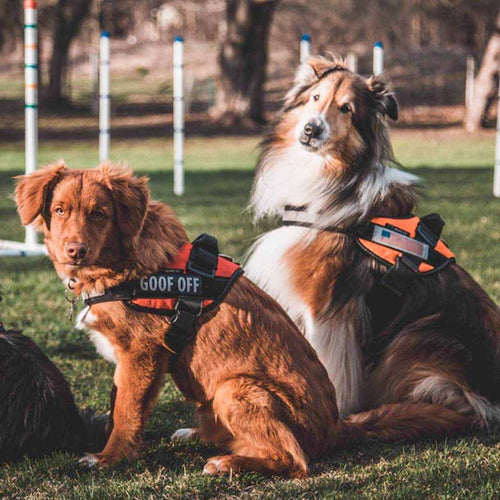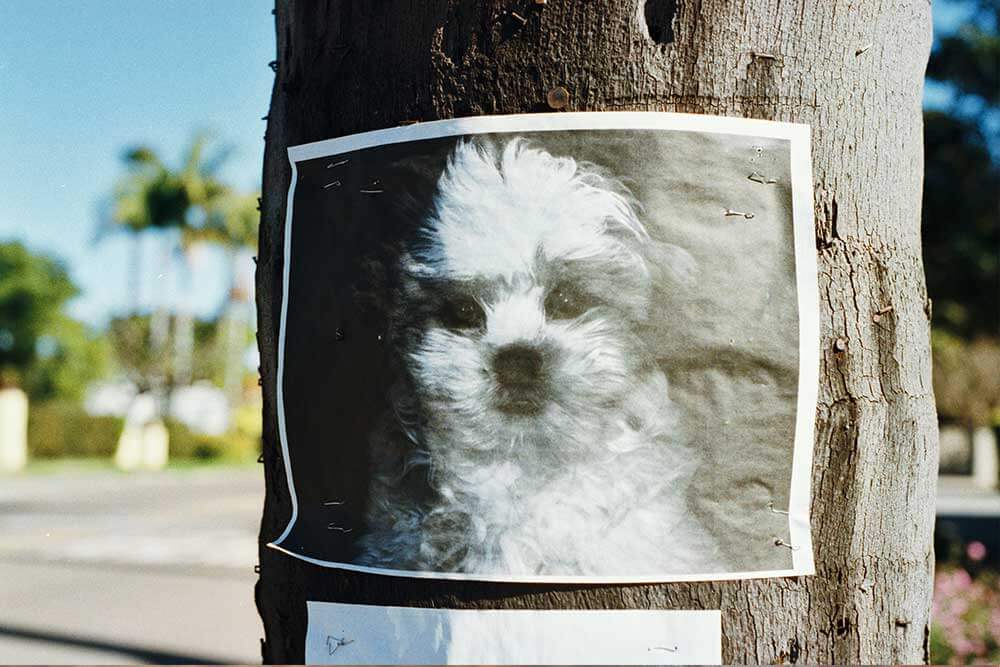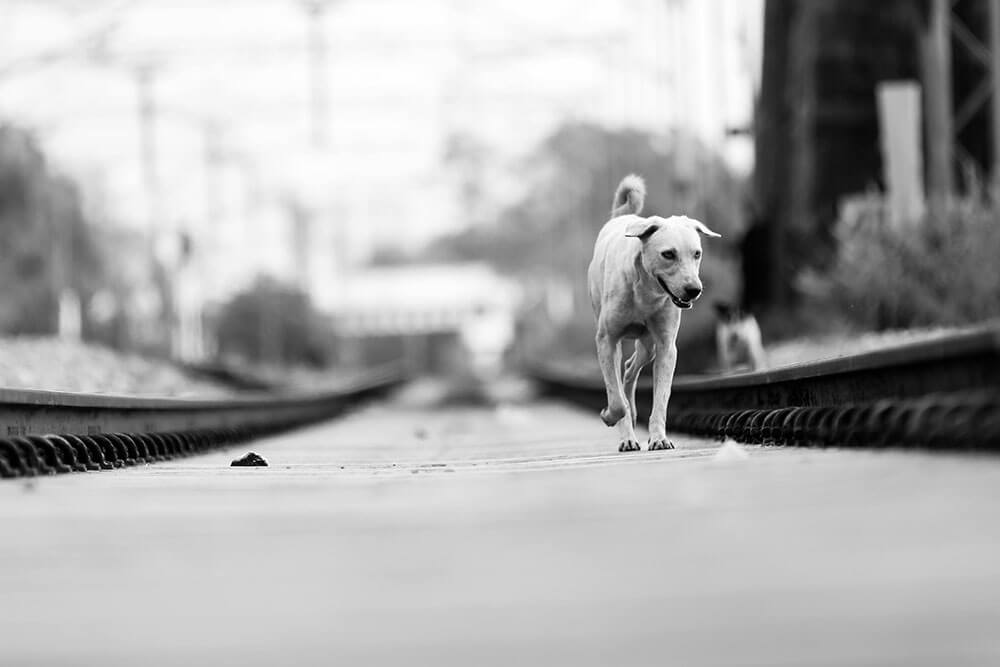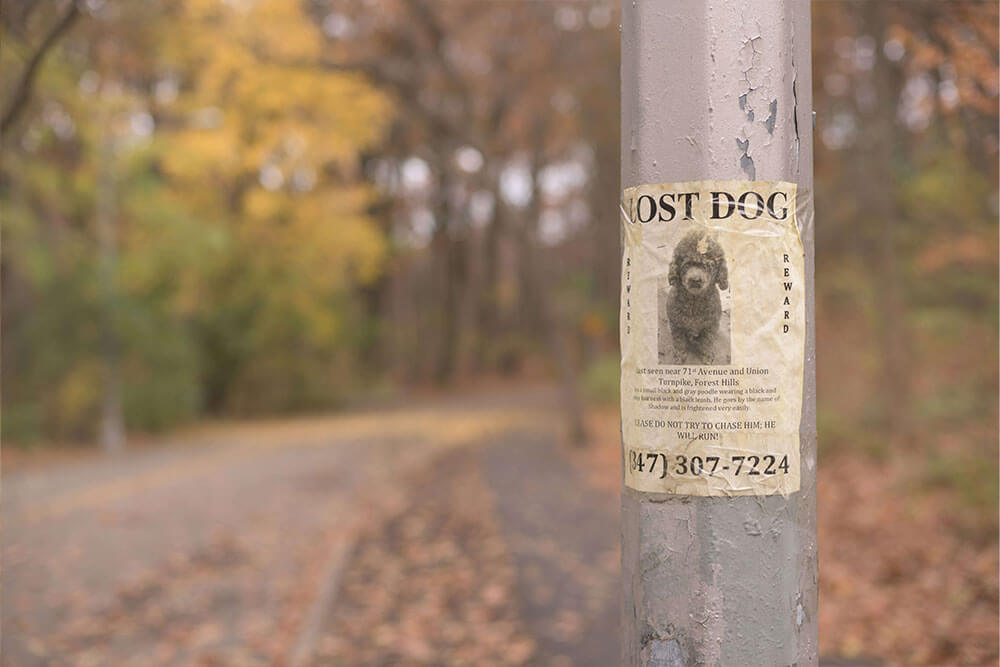When your dog gets lost, it's super stressful for both of you. But staying calm and acting fast are crucial. Here's a simple guide to help you find your furry friend ASAP:
-
Stay Calm and Act Fast
Staying calm is key: Panicking makes it tough to think straight. Take deep breaths and get ready to act smartly.
Act quickly: The faster you start searching, the better. Dogs often can't find their way back, so make the most of the first 48 hours.
-
Document Everything
It's best to keep track of your search digitally so you can easily share it with others lending a hand. Here's what you should keep tabs on during your dog search:
|
Dog Info
|
-
Detailed Dog Information: Note down your dog's breed, gender, age, size, primary color and physical characteristics, medical conditions, neuter/spay status, and personality. Note their temperament around strangers and other dogs, specific fears, and favorite things
-
Microchip Details: Keep a record of your dog's microchip info, including the number and company. Make sure this information is up to date with the microchip registry.
|
|
Volunteer Info
|
-
Volunteer Contact Info: Gather contact details of everyone helping out. Sending a group text to them can really speed up the search when it's urgent.
-
Assigned Tasks: Keep track of who's doing what. Whether it's you or someone managing the search, having clear roles helps keep things organized.
|
|
Sighting Info
|
-
Tip Contact Info: Collect contact details from anyone who gives a tip about your dog's location.
-
Sighting Details: Get exact info like the address, direction, and your dog's behavior (scared or exploring).
-
Map Sightings: Create a map of sightings with dates and times to track your dog's movements.
|
|
Shelters, Vets, and Rescue Groups Info
|
Maintain a list of shelters, rescue groups, and veterinary clinics in your area.
|
Tips:
-
Store all this info online using services like Dropbox or Google Drive. This way, you can access it instantly from any device in critical moments.
-
Program important phone numbers into your phone for quick access.
-
When someone gives you a tip, like a sighting, ask if you can record the conversation on your phone for better recall later.
-
Create and Distribute Flyer
Tips for Effective Flyer Design
Design a clear, eye-catching flyer. A good flyer should include:
-
Color Pallet: Use two or three colors for your flyer to keep it clear and impactful. Choose primary colors like red and yellow to convey urgency or emergency. Avoid pastels or overly dark shades.
-
Title: A clear, bold heading in all caps stating "LOST DOG".
-
Photo: Choose a recent, clear, and recognizable photo of your dog with a light background for printing, and include a reference point for size clarity.
-
A no-nonsense description
-
Dog’s name
-
Breed
-
Gender
-
Age, but only if your dog is a puppy or visibly elderly
-
Size
-
Primary color and other physical characteristics
-
Temperament around strangers and other dogs.
-
Medical conditions
-
Whether the dog is neutered/spayed
-
Whether the dog is microchipped
-
Color of collar, if applicable
-
Last-seen area and date
-
Add "DO NOT CHASE" in large font, and ask people to call you immediately while keeping an eye on your dog.
-
Phone Numbers: Include three or more cellphone numbers.
-
Reward: Consider using the word "REWARD" alone, without specifying the amount, if you're offering one.
-
Languages: In bilingual communities, make your sign in both languages.
-
Printing: Use a rain-proof cover (plastic sheet protectors, clear contact paper, or clear packing tape).
People Who Should Get a Copy of Flyer
Go door to door to share fliers with neighbors. Don't leave fliers in the box; hand them to neighbors directly. Let them know you're looking for a lost dog and kindly ask them to check their garages, sheds, and crawl spaces. In areas with cameras, ask to see footage. If they spot the dog, advise against chasing and to call you immediately. If they're not home, try again later or leave a flier taped to their front window or door after two visits.
Additionally, distribute flyers to people who are often outside in the area where your dog was last seen, like mail carriers, delivery drivers, trash collectors, dog walkers, joggers, and others who are frequently around.
Places to Post Flyers
Place flyers in busy areas like grocery stores, laundromats, community centers, intersections, bus stops, parks, and shopping districts. For schools or playgrounds, position them at kids' eye level.
Ask local businesses especially frequented by pet parents, like groomers, kennels, and pet supply stores, to display your flyer on their bulletin board or near the cash register.
Also, contact local animal shelters, rescue organizations, and veterinary clinics to inquire if your dog has been found there, and give them flyers. While at the shelter, ask to see their records of found dogs not brought in. Some people find lost dogs but keep them safe at home instead of taking them to the shelter. Also, inquire about their list of deceased animals picked up. Though it may seem grim, each search keeps hope alive. Remember, most lost dogs aren't on that list, so the odds are in your favor.
Tips:
-
Check your flyers every couple of days to ensure they're intact and readable. Replace or repair them after storms.
-
Create a simple map of where you've placed the signs and use it to maintain them properly.
-
If you receive sightings in a new area, put up new posters there promptly.
-
Last but not least, remove your flyers once your dog is found.
-
Utilize Online Resources
You can also share your digital flyer online. Consider these online platforms:
-
Social media
-
Lost dog and stray dog feeder Facebook groups. Make sure your Facebook post is set to public and shareable.
-
Your Twitter or Instagram, with location hashtags and tagging local lost dog accounts to spread your poster.
-
-
-
Stay Vigilant and Follow Up
-
Regularly check with local shelters, vets, online resources, and people who may have seen your dog.
-
Follow up on every lead to ensure thoroughness.
-
Beware of potential scams or individuals seeking a reward.
-
Avoid meeting someone alone who claims to have found your dog.
-
If offering a reward, don't carry cash with you when meeting someone.
-
Be cautious of calls from unlisted or blocked numbers regarding your dog.
-
If there are multiple sightings in one area, conduct a thorough search there.
-
Stay easily reachable. Keep your phone charged and with you always in case someone finds your pet.
-
Conduct a Search
Organize a Search Party
Get friends and neighbors to form a search party. Split the search area into zones for each person to cover, making the search more efficient.
If there are multiple adults at home, have one stay behind. Your dog might return on their own, and you'll need someone ready to catch them if they do.
Search Strategically
Before you start searching, consider:
-
Your dog's age, size, medical conditions, personality, and temperament around strangers and other dogs.
-
Specific fears and favorite activities.
-
Past Behavior. If your dog has escaped before, where was she previously found?
-
Reason for disappearance. Did she escape for an adventure? Was there thunder or fireworks? Did she run off to find a mate? Is she spayed or neutered? If not, when was her last heat cycle?
Based on this, plan the scope, location, and timing of your search.
Consider your dog's age, size, and medical conditions. Big, strong dogs, especially young ones, can run 5 miles or more. Small, old dogs may only manage half a mile. Unless you think your dog has traveled far, start your search where they were last seen and expand from there.
Think about places your dog might go based on their personality. Check high-probability areas first, then long-shot locations.
-
Outgoing dogs may head to parks or neighbor's yards.
-
Shy dogs might hide in corners, gutters, bushes and under cars.
-
Water-loving dogs may be near lakes or streams.
Check common areas where stray animals find food and water, like butcher food carts, restaurants, butcher shops, garbage dumps, drainage ditches, and streams..
If your dog runs away from home, start by thoroughly searching your home and yard. Look in unexpected places like under furniture, in closets, behind appliances, and in any small spaces they could hide. Don't forget to check the garage, basement, sheds, and under decks.
Expand your search area if initial efforts don’t yield results.
Consider both times and locations. Dogs are usually most active at dawn and dusk. If your dog is scared of strangers, search when the streets are quiet and people are asleep. If your dog was seen at a specific time, return to that area at the same time to catch people with regular routines.
Search Essentials
If your dog has a GPS or Bluetooth tracker, use the app to find their location quickly.
Instead of worrying about finding your lost dog, focus on how they can find their way back to you. Place your dog's bedding, toys, litter boxes, and your dirty clothes with familiar scents on the front porch and and other safe spots where your dog might visit. Use a plastic container to keep these items dry. It's best to use a motion-activated camera to see if your dog is here.
Walk (don’t drive or bike) around the neighborhood from your front door. This leaves a scent trail that your dog can follow back home. Note that heavy rain can wash away scent trails, so this may not be effective if it recently rained heavily.
Wear reflective clothing and carry a flashlight when searching at night.
Be prepared to safely transport your dog home once found.
Before you head out, make sure to mark your rear window. Driving around without a sign is a missed opportunity. Plus, seeing an unfamiliar car cruising slowly might make people uneasy. A sign will reassure them and make them more willing to help.
Use markers or a sign in the window with huge letters for easy reading while driving by. Aim for three or four rows of large letters, and use different colors for each word to grab attention. Ensure your window is clean and dry before starting. Example:
LOST GOLDEN RETRIEVER
9TH & 109TH
125-232-5724
Alternatively, consider a car top sign for better visibility, similar to those used by pizza delivery cars.
Tips for Searching
-
When searching, prioritize your safety with these tips:
-
Never leave your car running with the door open.
-
Stay hydrated by drinking plenty of water and take breaks during the search.
-
Respect property boundaries; always get permission before searching on private property.
-
When you’ve found your dog, consider these tips:
It might seem surprising, but calling your dog's name when they're lost can sometimes make things worse. They might have been scared by well-meaning strangers who tried to help but ended up frightening them. This could make your dog more wary of people trying to approach them. If they hear you calling their name in a stressed voice, it could make them even more anxious and cause them to run away. Instead of just calling their name, try other techniques listed below, especially focusing on calming signals.
When you spot a lost dog, your first instinct is to help by moving closer. But often, they'll run away, leading you to chase after them. However, dogs are usually faster than people. Instead of chasing, try using calming signals and other techniques to encourage them to approach you voluntarily. Chasing can scare them more. So, don't chase, even if it's your own dog.
If you spot your dog, use calming signals to encourage them to approach you. Sit down, avoid direct eye contact, and yawn or stretch. These actions can make you appear less threatening and more inviting to your dog.
Use a Friend: If your dog likes other dogs but isn't responding to calming signals, try using a friendly dog to attract them. Choose a happy, friendly dog that your dog knows and trusts. Take this dog, on a leash, to an area where your lost dog can see them. Focus on the friendly dog, giving them treats or playing with a ball, while ignoring your dog. This might encourage your dog to come over and join in.
Use Food: If your dog is motivated by food, bring strong-smelling treats like cheese or hot dogs, and familiar items like a blanket or favorite toy. Crinkle a treat bag or rattle a food dish and move a few steps away to lure them closer.
For skittish or hard-to-approach dogs, consider setting up a humane trap and monitoring it with a camera. Bait the trap with your dog’s favorite food and place it where they’ve been seen. Check the camera daily to see how your dog is reacting to the trap and adjust the angle or location if needed.
-
Fund and Emotional Support
Fundraising
If the cost of the search is beyond your means, use fundraising websites like Chip In. Many people will donate $10 to $50, and it adds up quickly.
Dealing with Stress and Anxiety
Losing a dog is incredibly stressful. It’s important to take care of yourself during this time. Lean on friends and family for support, and consider joining online communities or support groups for pet owners in similar situations.
Don’t Give Up
If your initial efforts don’t lead to your dog’s return, don’t lose hope. Continue to update and repost flyers and social media posts. Regularly check with shelters and vet clinics. Remember that many dogs are found weeks or even months after they go missing.
Preparing for the Worst
While you hope for the best, it’s important to be prepared for difficult outcomes when searching for a lost dog.
-
Seeking Professional Help
If you've tried everything and still can't find your beloved dog, professional help may be the next step:
-
Pet Detectives and Trackers: These professionals specialize in locating lost pets. They may use tracker dogs, live traps, aerial surveillance, or trail cameras to find your dog.
-
Volunteer Networks: There are volunteer groups that organize large search parties and create custom search plans based on your dog's behavior and sightings. They rely on donations and can provide valuable assistance.
Tips:
-
Provide concrete actions for helpers, such as distributing flyers and sharing information.
-
Keep records of any paid services, including receipts and contracts.
-
Understand that paying for search services doesn't guarantee your dog's return.
-
Prevention is Key to Dog Safety
Losing a dog is distressing, but proactive steps can minimize the risk. Microchip your dog,
provide proper identification, secure your home and yard, and train them with recall commands to keep them safe and prevent them from going missing.
FAQs:
-
Do dogs panic when lost?
Yes, dogs can panic when they get lost. When a dog becomes separated from its owner, it can experience high levels of stress and anxiety. This often triggers their fight or flight response, causing them to go into "survival mode." In this state, they focus solely on finding food, water, and shelter, and may avoid interactions with people or other animals.
-
How do dogs survive when lost?
Dogs have remarkable survival skills when they get lost. They can use their strong sense of smell and hearing to find food and water. Dogs are also capable of seeking shelter to protect themselves from harsh weather. However, this depends on the breed. Larger breeds like German Shepherds and Huskies survive longer than smaller breeds like Corgis.
-
Can dogs find their way home if they are lost?
Yes, dogs can often find their way home if they are lost. They have a strong sense of smell and hearing, which helps them navigate and recognize familiar routes back home.
-
How far do lost dogs usually travel?
Lost dogs usually stay within a few miles of where they were lost, often within 2-5 miles. However, some dogs can travel much farther, depending on their age, size, and medical conditions. Big, strong dogs, especially young ones, can run 5 miles or more. Small, old dogs may only manage half a mile.
-
When to stop looking for a lost dog?
There is no definitive answer to when you should stop looking for a lost dog. As a dog owner, your pet is part of your family, and you wouldn't give up on searching for a family member. Ultimately, you must decide when to accept that your dog is gone and when it is time to mourn, celebrate their life, and allow yourself to grieve.
Further Reading:




























